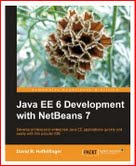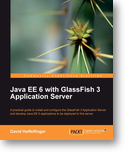Both JDK 1.6 and GlassFish come bundled with Java DB, which is nothing but a rebranded Apache Derby RDBMS. If you have ever done anything with Derby, you know that a database can be created by simply by passing the create attribute with a value of true. For example, to create a database on a server called myserver.com, all that is needed is to use the following JDBC URL:
jdbc:derby://myserver.com:1527/mydb;user=foo;password=bar;create=true
The above JDBC URL will create a database called "mydb", and, in Derby/Java DB, the default schema matches the user name, so the above URL will create a schema called "foo" and set it as the default schema.
This is great in the sense that creating a database is very easy, but it is not so great in the sense that it allows anybody to create a database on the server and do whatever they want with it.
If this wasn't bad enough, by default passwords are ignored, therefore, with the default configuration in place, anybody can connect to the database as user "foo", for example, the following JDBC URL would connect you just fine:
jdbc:derby://myserver.com:1527/mydb;user=foo;password=aaa
Notice that in this second JDBC URL, the password is different than the one we used when we created the database, it doesn't matter, in the default Derby configuration, the password is ignored, it is as if it didn't exist, therefore this URL would allow us to log in just fine.
Standalone Derby / Java DB only listens for connections from localhost, so in this case the default behavior is not too bad (there is still some security risk in a server with multiple users, however random people cannot connect through the network and create databases/log in to a database willy nilly).
However, GlassFish comes bundled with Java DB/Derby. When starting the database through GlassFish's asadmin utility:
asadmin start-database
The database by default listens accepts network connections. Unfortunately all other (lack of) security defaults stay in place, therefore with GlassFish's JavaDB's default configuration, random Joe's out there can connect to our databases without using a password, and can also create their own databases. This is a major security hole.
Luckily, Java DB/Derby can be easily configured to require valid user credentials, it is unfortunate that it is not configured this way by default. There are various ways to configure authentication in Derby/Java DB, it can be "hooked up" to an LDAP server, additionally, custom code can be written to handle authentication, and finally, a property file can be written set up authentication. The Derby Developer's Guide has all the details, in this entry, I'll just explain the simplest way, in case you are panicking because I just made you realized your database is exposed to the world.
The property file to create to enable authentication has to be called derby.properties it should look something like this:
derby.connection.requireAuthentication=true
derby.authentication.provider=BUILTIN
# Users definition
derby.user.someusername=password1
derby.user.john=doe
derby.connection.requireAuthentication=true tells Derby/Java DB that authentication is required.
derby.authentication.provider=BUILTIN sets up Derby to use its internal, built-in authentication mechanism.
After setting the above two properties, we need to add some users, they are added as shown in the above sample derby.properties file, properties preceeded by "derby.user." are understood to be users, the user name is the string immediately following "derby.user.", and the password is the value to the right of the equal sign. For example, if we wanted to add another user with a username of "joe", and a password of "secret", we would add the following line to derby.properties:
derby.user.joe=secret
Once we have created this file, we need to put it in $DERBY_HOME/bin if we are using the standalone Java DB/Derby or the Java DB version that is bundled with JDK 1.6. Java DB is placed under $JAVA_HOME/db in in Linux and under C:\Program Files\Sun\JavaDB in Windows.
If we are using the Java DB version that is included with GlassFish, then the derby.properties file needs to be placed under $GLASSFISH_HOME/databases, where $GLASSFISH_HOME is the directory where GlassFish is installed.
After copying the file to the appropriate location, the Java DB/Derby needs to be restarted for the changes to take effect.
Posted by David R. Heffelfinger
@ 10:14 PM EDT







